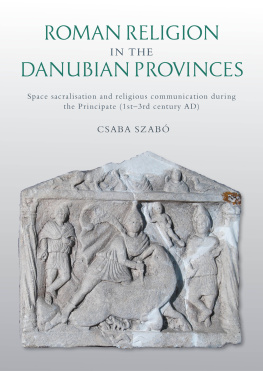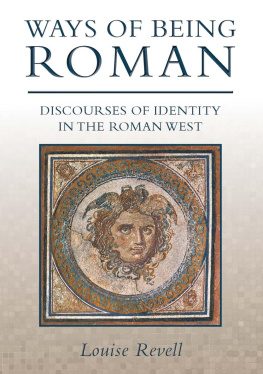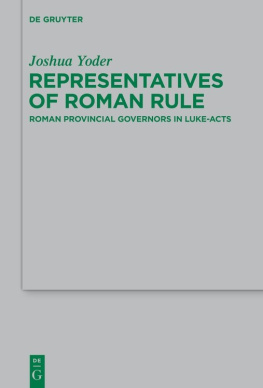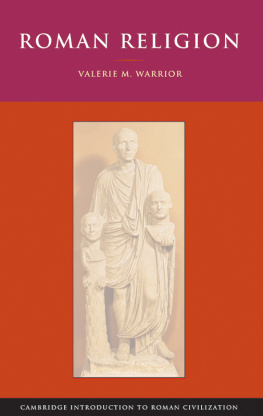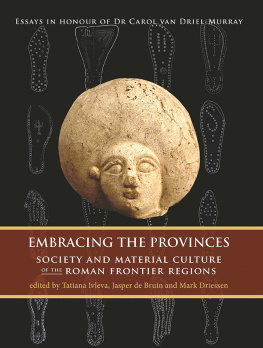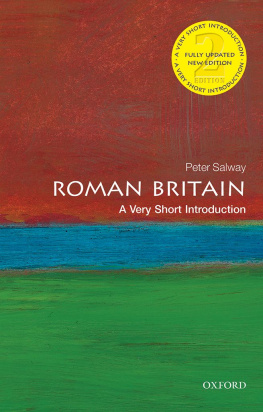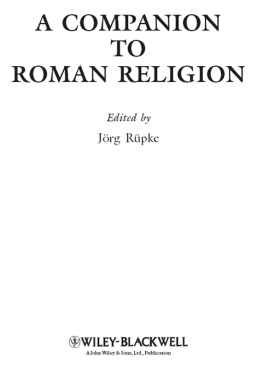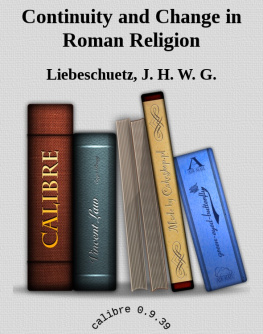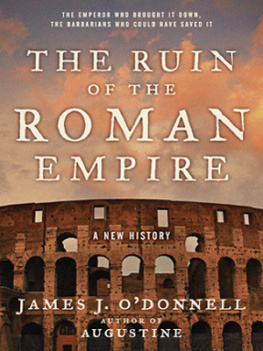


Published in the United Kingdom in 2022 by
OXBOW BOOKS
The Old Music Hall, 106108 Cowley Road, Oxford, OX4 1JE
and in the United States by
OXBOW BOOKS
1950 Lawrence Road, Havertown, PA 19083
Oxbow Books and the author 2022
Paperback Edition: ISBN 978-1-78925-783-0
Digital Edition: ISBN 978-1-78925-784-7
A CIP record for this book is available from the British Library
Library of Congress Control Number: 2022930862
All rights reserved. No part of this book may be reproduced or transmitted in any form or by any means, electronic or mechanical including photocopying, recording or by any information storage and retrieval system, without permission from the publisher in writing.
This book was supported by the Postdoctoral Research Grant PD NKFI-8 no. 127948 by the National Research, Development, and Innovation Office of Hungary (20182021). See also:
www.danubianreligion.com.
Printed in the United Kingdom by Short Run Press
Typeset in India by Lapiz Digital Services, Chennai.
For a complete list of Oxbow titles, please contact:
UNITED KINGDOM
Oxbow Books
Telephone (01865) 241249
Email:
www.oxbowbooks.com
UNITED STATES OF AMERICA
Oxbow Books
Telephone (610) 853-9131, Fax (610) 853-9146
Email:
www.casemateacademic.com/oxbow
Oxbow Books is part of the Casemate Group
Front cover: Roman Mithraic relief from Dacia (Dragu, Salaj county). Photo in custody of the National History Museum of Transylvania, Cluj-Napoca, Romania (inv. no. 15812).
Contents
List of figures
List of abbreviations
| A | LAnne pigraphique. |
| ANRW | Haase, W. Temporini, H. (eds), Aufstieg und Niedergang der rmischen Welt/Rise and Decline of the Roman World. Geschichte und Kultur Roms im Spiegel der neueren Forschung. Berlin-New York, 1972???. |
| BBRD | Boda, I. Szab, C., Bibliography of Roman Religion in Dacia . Cluj-Napoca, 2014. |
| CCID | Hrg, M. Schwertheim, E., Corpus Cultus Iovis Dolicheni, tudes prliminaires aux religions orientales dans lEmpire romain 106 . Leiden, 1987. |
| CIGD | Ruscu, L., Corpus inscriptionum Graecarum Dacicarum, Hungarian Polis Studies 10 . Debrecen, 2003. |
| CIL | Corpus Inscriptionum Latinarum. Consilio et auctoritate Academiae Litterarum Regiae Borussicae editum. |
| CIMRM | Vermaseren, M. J., Corpus Inscriptionum et Monumentorum Religionis Mithriacae III . The Hague, 19561960. |
| Clauss-Slaby | Epigraphik Dantebank Clauss-Slaby. |
| CSIR | Corpus Signorum Imperii Romani. |
| DAS | The Digital Atlas of Roman Sanctuaries in the Danubian Provinces. |
| DMA | Digital Map of Apulum. |
| EDH | Epigraphic Database Heidelberg. |
| EPRO | tudes prliminaires aux religions orientales dans lEmpire romain (founded by M. J. Vermaseren). |
| HA | Scriptores historiae Augustae. |
| IDR | Inscriptiones Daciae Romanae IIII . Bucureti/Paris, 1975. |
| IG | Inscriptiones Graecae. |
| IGLN | J. Kolendo V. Boilova (eds), Inscriptions Greques et Latines de Novae (Msie Infrieure) . Bordeaux 1997. |
| IGUR | Inscriptiones Graecae Urbis Romae IIV. Rome, 19711990. |
| ILD | Petolescu, C. C., Inscripii latine din Dacia ( Inscriptiones Latinae Dacicae ). Bucureti, 2005. |
| ILJug | ael, Anna ael, Jaroslav, Inscriptiones latinae quae in Iugoslavia inter annos MCMII et MCMXL repertae et editae sunt . Ljubljana, Situla, 1986. |
| ILS | Dessau, Hermann, Inscriptiones Latinae Selectae . Berlin, 18921916, 3 vols. |
| IMS | Papazoglou. Fanoula Mirkovic, Miroslava, Inscriptions de la Mesie Superieure . Beograd, Centre dtudes epigraphiques et numismatiques, 1976. |
| LIMC | Lexicon Iconographicum Mythologiae Classicae, Zrich, Mnchen, Dsseldorf, 19811999 and 2009. |
| LTUR | Steinby, E. M. (ed.), Lexicon Topographicum Urbis Romae. 19932000). |
| Lupa | Ubi Erat Lupa Bilddatenbank zu antiken Steindenkmlern (lupa.at). |
| MMM | Cumont, F. V., Textes et monuments figurs relatifs aux Mystres de Mithra: pub. avec une introduction critique . Bruxelles, 18941896. |
| OPEL | Lorincz, Barnabs Redo, Franciscus (eds), Onomasticon Provinciarum Europae Latinarum. Budapest-Wien, 19942002. |
| RIU | Barkczi, L. Mcsy, A., Die rmischen Inschriften Ungarns . Amsterdam, 19721991. |
| Tit. Aq. | Kovcs, P. Szab, ., Tituli Aquincenses IIII. Vol. 1. Tituli operum publicorum et honorarii et sacri, Szab, dm (ed.) ... [ et al. ] Vol. 2. Tituli sepulcrales et alii Budapestini reperti , with the help of Fehr Bence Borhy, Lszl (eds)... [ et al. ] Vol. 3. Tituli instrumenti domestici, cura Fehr, Bence. Budapest, 20092011. |
Foreword
During the course of my doctoral studies, I have participated in numerous international conferences, workshops and meetings focusing on Roman religion or the materiality of religion from antiquity. At most of these events, there were few usually two or three participants from Central-Eastern Europe. Very often, these scholars came from a classical archaeological background and had a very poor opinion of scholars of religious studies. Two worlds were meeting in these spaces: the world of classical, often outdated positivist and Kossinna-type archaeology of the provinces, and the highly theoreticised and often too-abstract field of religious studies searching for the obscure notion of material religion. Their theoretical conflict and methodological incompatibility were very provocative and appealing for me: I realised that uniting Roman religious studies with provincial archaeology represents one of the most innovative scientific methods one that can unite Western and Eastern European scholarship and create a lived academic dialogue, perhaps ultimately attracting more young scholars from Central-Eastern Europe to the discipline.
The Danubian provinces have long occupied a well-established position in Roman provincial archaeology. These include the century-old Limesforschung (study of Limes) in this region; the historical link between Central-Eastern European scholarship and the Austrian and German archaeological traditions; the visits and infrequent but impactful connections between Sir Ronald Syme, Sheppard Frere, John Wilkes, Andrew Wilson and others in the Danubian region; and the general contemporary dialogue between archaeologists from this region of Europe. All of these provide a good start for the development of new methodological perspectives.
My previous work, which focused on the sacralised spaces and religious communication in Roman Dacia, was the result of an early attempt to unite these two often conflicting disciplines and to open a dialogue between religious studies and provincial archaeology in Romania and Hungary, where this tradition is still in its infancy. The work was received surprisingly well, although the interest came especially from Western scholars: from the 11 known reviews, just four were published in Central-Eastern Europe. Until recently, this book was one of just a few case studies in which the innovative methodology of lived ancient religion approach of Jrg Rpke and his team from Erfurt was tested against the materiality of religion from the Danubian provinces of the Roman Empire.
Next page
